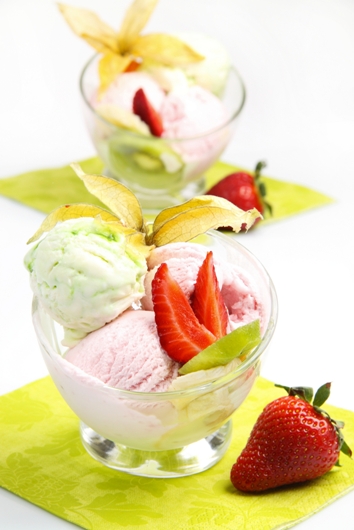Triple digit temperatures have hit the Central Atlantic once again, leaving locals and visitors alike to find any way they can to keep the mercury down. Some become shut-ins moving between their air-conditioned homes to their air-conditioned cars to their air-conditioned jobs and back again; some take to the beaches, lakes and pools to swim and soak the heat away; still others turn to cold drinks, ices and of course, ice cream to keep cool.
The origins of ice cream are a convoluted tangle of misinformation and repetition. Alternately the Persians, Chinese, Arabs and Indians are credited with inventing ice cream. This seems to happen because non-dairy puddings and other chilled desserts are treated as synonymous with ice cream – causing a confusion of substance, time and place.
Although the Chinese seem to get the most credit for developing ice cream, the one really important thing bothers me about this version of history is that milk and milk products do not form a large part of the Chinese diet. The Tibetans and of course the Mongolians have lots of dairy in their diets, but the Han Chinese and other ethnic groups do not. Although a modern artisanal cheese industry is today taking root in China and producing Gouda and other western varieties, traditionally, cheese is not something associated with Chinese food. Bean curd-based concoctions, whether fried, or in soup or pudding form, these are often referred to as, “Chinese cheese”. There are only two traditional buffalo milk-based puddings that are sometimes eaten chilled that have any relation to ice cream, namely Jiang Zhuang Nai – the sweet gingery pudding and Shuang Pi Nai – which is a sweetened, cooked custard of milk and egg whites encased between two milk skins.
The pages of Marco Polo’s Travels record a lot of milk being enjoyed as cheese, curds, yogurt, milk, and even a sort of vodka (arkhi) in the Yuan court. So after the 13th Century, milk enters the Chinese diet through the Mongolian-led dynasty. However there is no mention of ice-cream, or anything resembling it.
In the Song Dynasty (960-1279), however, a poem entitled Ode to the Ice Cheese “詠冰酪” was written by the poet Yang Wanli (1127–1206).
It looks so smooth but still has a crisp texture,
It appears congealed and yet it seems to float.
Like jade, it breaks at the bottom of the dish;
As with snow, it melts in the light of the sun.
So it’s still possible that the roots of ice cream in China preceded the rule of the Mongols. But from where did the idea come from? Was it indeed an indigenous Chinese idea, or was it an adaptation of an idea that came from far-away shores?
Although information is hard to come by, a few pieces of information have solid references behind them. Ice harvested in the winter or from ice-covered mountainous regions and then used to increase the storage time of foods has been used in many cultures for millennia. The Persians had yakhchals to keep the ice frozen during the warm seasons and the Chinese and Mesopotamians had icehouses. Documentary sources exist of orders of ice coming from pharaonic Egypt to keep food in the warmest months.
The first recorded ice-dessert are honey and fruit flavored sorbets offered for sale in Athenian markets in the 5th Century BCE. Both the Persians and the Chinese enjoyed ice or snow flavored with honey and fruit or sugary syrups. For the Persians, sherbet was more of a drink than the frozen dessert we now know by the same name. In the 4th Century BCE, the Persians were enjoying an ancestor of today’s chilled faloodeh pudding made from vermicelli noodles, rosewater, lime juice and a bit of cornstarch for thickening.
The next data point we have is from Pliny, recording Emperor Nero (54 to 68 CE) sending slaves to the mountains to gather snow and ice for as a basis for desserts flavored with berries and nuts. This doesn’t seem to be an advance on what the Greeks were doing five centuries earlier, but rather a simple repetition of a great idea.

So, to the first century CE, we have ice and snow-based desserts flavored with fruit, nuts and syrups, in both east and west, chilled drinks on a shaved or crushed ice base in the west, and a rocking, chilled wheat based pudding also in the west. The next innovation that I have come across that walks us a step closer to ice cream is the addition of buffalo milk to the faloodeh. This seems to have occurred in China’s Tang Dynasty (618 to 907 CE) where a frozen concoction of milk, flour and camphor was enjoyed in the royal court.
Interestingly, I’ve seen references (that I cannot, at present, confirm) to the Indian use of ice and salt to create an endothermic reaction used to lower the temperature of other substances as early as the 4th Century CE. Also the Arabs are credited with being the first to sweeten ice-desserts with sugar instead of honey or fruit juice. By the 10th Century CE, ice cream was widespread amongst many of the Arab world’s major cities, such as Baghdad, Damascus and Cairo.
Greeks, Persians, Chinese, Arabs, and Indians all can be referenced with developing some part of the process of freezing and flavoring ice, milk or cream to come up with ice cream. Sounds like a Silk Road creation to me – eh? I see ideas flowing around the globe, innovations taking place and being passed on to the next place until a precursor to the modern product emerged.
Today, some amazing innovation in ice cream flavors are coming out of Hong Kong – including: Sichuan pepper and Morello cherry flavored ice cream. Other flavors offered include: black sesame, jasmine tea, pear and port and even gorgonzola ice cream. (Words by Laura Kelley).

